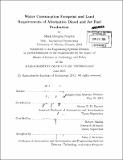| dc.contributor.advisor | Steven R. H. Barrett Robert Malina. | en_US |
| dc.contributor.author | Staples, Mark Douglas | en_US |
| dc.contributor.other | Massachusetts Institute of Technology. Engineering Systems Division. | en_US |
| dc.date.accessioned | 2013-09-24T19:44:51Z | |
| dc.date.available | 2013-09-24T19:44:51Z | |
| dc.date.copyright | 2013 | en_US |
| dc.date.issued | 2013 | en_US |
| dc.identifier.uri | http://hdl.handle.net/1721.1/81130 | |
| dc.description | Thesis (S.M. in Technology and Policy)--Massachusetts Institute of Technology, Engineering Systems Division, 2013. | en_US |
| dc.description | Cataloged from PDF version of thesis. | en_US |
| dc.description | Includes bibliographical references (p. 101-110). | en_US |
| dc.description.abstract | The Renewable Fuels Standard 2 (RFS2) is an important component of alternative transportation fuels policy in the United States (US). By mandating the production of alternative fuels, RFS2 attempts to address a number of imperfections in the transportation fuels market: US economic vulnerability to volatile prices; security and environmental externalities; and a lack of investment in alternatives to petroleum-derived fuels. Although RFS2 aims to reduce the climate impact of transportation fuels, the policy raises a number of additional environmental concerns, including the water and land resource requirements of alternative fuel production. These factors should be considered in order to determine the overall environmental viability of alternatives to petroleum-derived transportation fuels. Middle distillate (MD) fuels, including diesel and jet fuel, are of particular interest because they currently make up almost 30% of liquid fuel consumption in the US, and alternative MD fuels could potentially satisfy 21 of the 36 billion gallons of renewable fuels mandated by RFS2 in 2022. This thesis quantifies the lifecycle blue (surface and ground) water consumption footprint of MD from conventional crude oil; Fischer-Tropsch (FT) MD from natural gas and coal; fermentation and advanced fermentation (AF) MD from biomass; and hydroprocessed esters and fatty acids (HEFA) MD and biodiesel from oilseed crops, in the US. FT and rainfed biomass-derived MD have lifecycle blue water consumption footprints between 1.4 and 18.1 lwater/lMD, comparable to conventional MD, between 4.1 and 7.5 lwater/lMD. Irrigated biomass-derived MD has a lifecycle blue water consumption footprint potentially several orders of magnitude larger, between 2.5 and 5300 lwater/lMD. Results are geospatially disaggregated, and the trade-offs between blue water consumption footprint and areal MD productivity, between 490 and 3710 lMD/ha, are quantified under assumptions of rainfed and irrigated biomass cultivation. | en_US |
| dc.description.statementofresponsibility | by Mark Douglas Staples. | en_US |
| dc.format.extent | 110 p. | en_US |
| dc.language.iso | eng | en_US |
| dc.publisher | Massachusetts Institute of Technology | en_US |
| dc.rights | M.I.T. theses are protected by
copyright. They may be viewed from this source for any purpose, but
reproduction or distribution in any format is prohibited without written
permission. See provided URL for inquiries about permission. | en_US |
| dc.rights.uri | http://dspace.mit.edu/handle/1721.1/7582 | en_US |
| dc.subject | Engineering Systems Division. | en_US |
| dc.title | Water consumption footprint and land requirements of alternative diesel and jet fuel | en_US |
| dc.type | Thesis | en_US |
| dc.description.degree | S.M.in Technology and Policy | en_US |
| dc.contributor.department | Massachusetts Institute of Technology. Engineering Systems Division | |
| dc.identifier.oclc | 858280572 | en_US |
